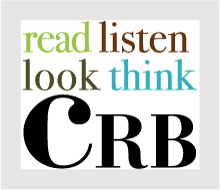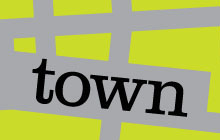By Mariel Brown
First published in Caribbean Beat, May/June 2008
It’s Friday night in Port of Spain. No doubt, as on any Friday night in any city around the world, people are getting ready to go out, to any one or combination of an assortment of bars, clubs, lounges and rum shops. I’m heading to Alice Yard for “Conversations in the Yard.” A place that doesn’t quite fit any of the aforementioned categories, in essence, Alice Yard is really no more than its name implies: a yard, a paved area in the back of an old house on Roberts Street, in Woodbrook, an old-fashioned, middle-class suburb of the city. And yet it’s become a regular Friday-night spot for a certain small crowd.
“Conversations in the Yard” is a weekly event organised by Sheldon Holder, singer-songwriter from 12 the Band, in which someone with a specific area of interest or expertise leads a conversation. Sometimes musical groups perform or artists show their work; some weeks there’s a guest DJ playing his or her favourite tunes—amateurs only: it seems the criterion for spinning at the yard is a love for all kinds of music, and you’re as likely to hear Billie Holiday as you are to hear the Renegades steel orchestra’s rendition of Pan in A Minor. Some nights there’s just a handful of people liming, and other nights a hundred people will squeeze into the tiny space. Everything is open to the public, and there’s no cover charge.
It’s 9.30 pm, and despite the fact that every e-mail flier says come for 9, things tend not to get started there much before 10. So I don my T-shirt and flip-flops (a dress code would be anathema to the place) and head down to “the yard” (as it’s affectionately called).
Tonight two designers are launching lines of T-shirts, a local rap group is performing, an artist is sprawled on sheets of cardboard on the ground, and another artist has installed a bay-leaf-strewn “chicken coop” in one of the outbuildings.
Graphic artist Nigel Des Vignes has a full pot of corn soup bubbling away on a gas ring on the ground. He says he’s recreating Charlotte Street—a downtown street where the roadway doubles as a vegetable market—so there are hands of green figs, limes and ground provisions strewn about the place. In between, Des Vignes displays his T-shirts in cut lengths of bamboo and pinned to a clothesline. Architect Terrence Smith has rolled his line of T-shirts (which he calls “Old”) into discarded beer cases. People drift between the installations, trying not to tread on Michelle Isava, who’s scribbling abstract doodles on her cardboard mattress. They’re obviously discomfited by her—a beautiful, pale-skinned vagrant who seems oblivious to everyone around. There are drinks for sale at an ad-hoc bar, and stewed chicken with red beans and rice. A guest DJ is playing roots reggae.
It’s a strange, interesting, fragmented sort of night. Looking around at everyone doing their own thing, it’s hard to tell who’s in charge here. And in a way, this combination of creative exploration and quiet anarchy is what the creators of the space would want most.
*
Alice Yard came into being in September 2006, during “Galvanise,” a six-week-long programme of contemporary art and performance activities set in various traditional and non-traditional venues around Port of Spain. Sean Leonard, an architect and custodian of the property, says he had been wanting to create a space “where things could be made.” At the time, 12 the Band was in need of a rehearsal space, and artist Jaime Lee Loy was desperate to find an exhibition site for her “Galvanise” installation. “It would give me the opportunity to play,” explains Leonard, “and to enter into live investigations of the potential of the urban yard space.”
The yard at 80 Roberts Street is familiar territory to Leonard, who spent much of his childhood playing with his siblings and the neighbourhood children in what was then his great-grandmother Alice’s backyard. Leonard says Alice is a kind of mythical figure to him: “She was always feeding everybody: panmen, people in the street. The composition in the house was always changing. She had a soft but respectful and powerful presence.”
In fact, when Leonard first took Sheldon Holder to see the property, Holder says he felt a great energy coming from the place.
“It’s a special yard to me,” says Leonard. “Generations of my family have spent time there. My parents had their wedding reception there; my mum’s wedding dress was made there; my first night-mas [Carnival] band started there. It’s always been like that: very active, creative. Full of tension.”
For Holder, the offer of a room, however modest, was opportune. “When Sean brought me to the place at first,” says Holder, “it was a 10-by-13-foot storeroom, literally, and I was like, ‘I wonder if this will really work, boy.’ I was like, ‘Man, if we getting we own place, no matter the size, we’ll make it cut.’”
So 12 took over the storeroom and made it into a soundproof bandroom, Jaime Lee Loy held her exhibition and Alice Yard, the contemporary art and music space, was born.
In September 2007, in collaboration with artist Christopher Cozier and writer Nicholas Laughlin, Leonard opened “The Alice Yard Space,” an exhibition area in the yard. It’s a modest space, rather like a large box with a glass front and halogen lights, which, since the closure of the CCA7 gallery in mid-2007, has been providing a venue for experimental art practice.
“The break-up of CCA7 was depressing,” says Laughlin, “and the commercial art scene is depressing. It all seemed like dead ends. But Alice Yard feels like a kind of opening up instead of closing down.
“I also feel there’s a kind selflessness about Sean and the way he’s going about the thing: the sense of modest improvisation, the emphasis on conversation and collaboration, on quiet, effective work rather than grand pronouncements. There’s also the hopefulness of Alice Yard, of the whole venture.”
Holder says Alice Yard is “an attempt to serve people from on the ground. It really is meant to evolve into a sort of community centre—a resource for everything creative.”
Fundamentally, the yard exists to serve artists and musicians. Whilst the Friday-night lime might be a cool scene and attract an interesting hodgepodge of onlookers and limers, there’s a kind of nonchalance that suggests this really isn’t about the consumer. In fact, Sheldon Holder gets antsy if he thinks there are too many people there. He’ll opt, defiantly, not to send out an e-mail shot or not to organise a performance or a “conversation” the next week, so that the vibe at the yard can realign itself. Holder’s attitude is quite extraordinary when you consider the prevailing night-spot culture, where the public relations machines work to bring in the clientele. The yard’s lack of pretence and marketing strategy is refreshing.
*
Spotrushaz, a local rap group, is explaining to an audience member why they rap with American accents. Some people listen intently to the discussion, others carry on their own conversations, and Nigel Des Vignes offers me a cup of his “best” corn soup and encourages people to pick the limes up off the ground and take them home: “Like allyuh don’t know how expensive limes are these days!” It’s all in a night at Alice Yard.
Tuesday, May 6, 2008
Subscribe to:
Posts (Atom)






